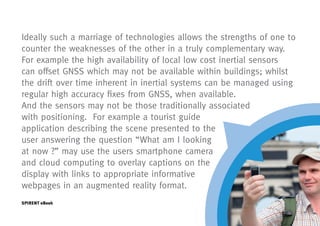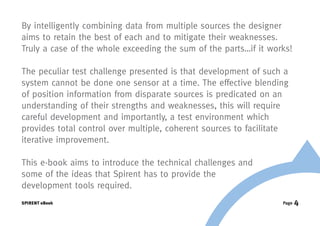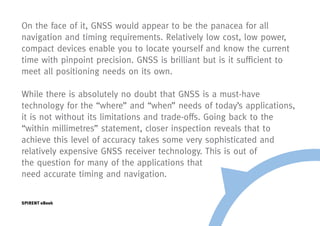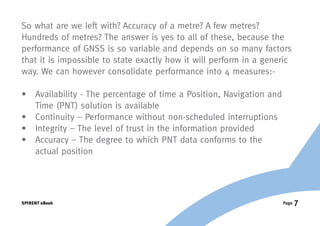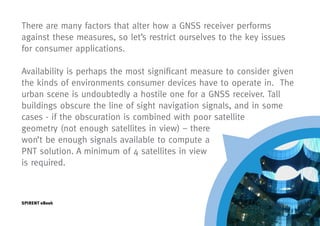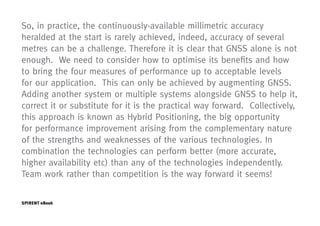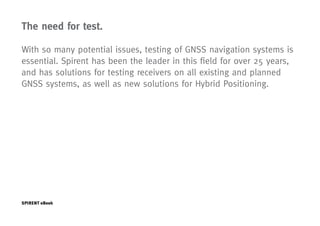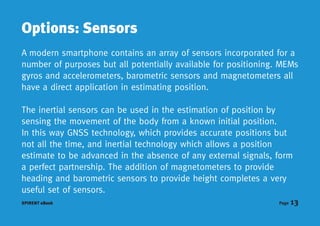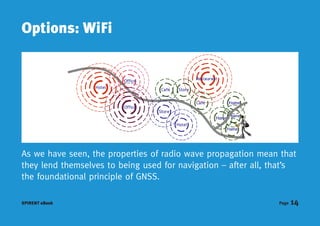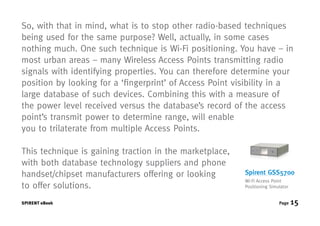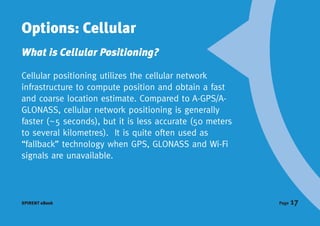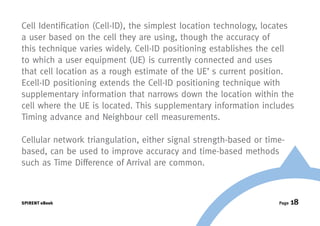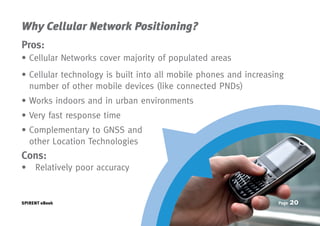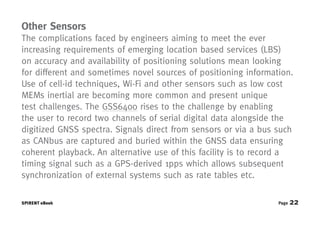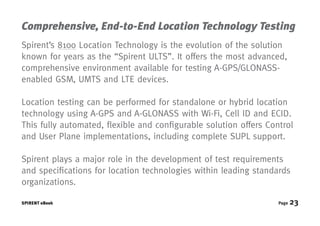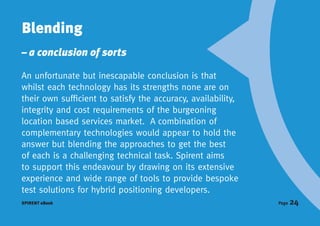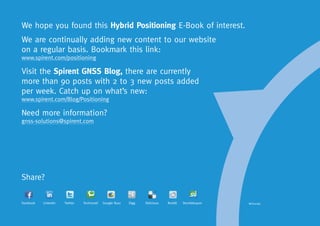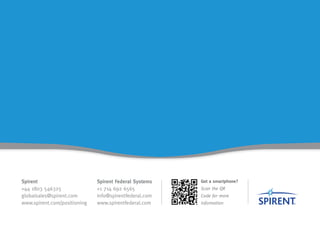Hybrid Positioning
- 2. The Challenge As the adoption of location based services becomes more main- stream, developers are looking for increased accuracy and availability from positioning solutions. For example services that target marketing messages need to know which display the user lingered at, not merely which store they are in, and ideally they would know in which direction the user is facing! To provide ubiquitous positioning that reaches indoors and positively identifies location and orientation in a multi-story building requires blending the best of multiple sources of information, in other words, a hybrid solution. SPIRENT eBook Page 2
- 3. Ideally such a marriage of technologies allows the strengths of one to counter the weaknesses of the other in a truly complementary way. For example the high availability of local low cost inertial sensors can offset GNSS which may not be available within buildings; whilst the drift over time inherent in inertial systems can be managed using regular high accuracy fixes from GNSS, when available. And the sensors may not be those traditionally associated with positioning. For example a tourist guide application describing the scene presented to the user answering the question ŌĆ£What am I looking at now ?ŌĆØ may use the users smartphone camera and cloud computing to overlay captions on the display with links to appropriate informative webpages in an augmented reality format. SPIRENT eBook
- 4. By intelligently combining data from multiple sources the designer aims to retain the best of each and to mitigate their weaknesses. Truly a case of the whole exceeding the sum of the partsŌĆ”if it works! The peculiar test challenge presented is that development of such a system cannot be done one sensor at a time. The effective blending of position information from disparate sources is predicated on an understanding of their strengths and weaknesses, this will require careful development and importantly, a test environment which provides total control over multiple, coherent sources to facilitate iterative improvement. This e-book aims to introduce the technical challenges and some of the ideas that Spirent has to provide the development tools required. SPIRENT eBook Page 4
- 5. Existing Technology GNSS alone ŌĆ£Global Navigation Satellite Systems (GNSS) enable you to locate your position anywhere on the earth ŌĆō or around it ŌĆō to within millimetresŌĆØ. Now, you have to admit that is an amazing statement, and in some cases it is perfectly true, but there are limits to this incredible technologies capability. Navigating, autonomously, using signals from satellites orbiting some 12500km away is an almost unbelievable technological achievement and has been the solution to a myriad of application needs, where knowing ŌĆśwhereŌĆÖ and ŌĆśwhenŌĆÖ you are is important. And, the list of applications for GNSS navigation is growing all the time. SPIRENT eBook Page 5
- 6. On the face of it, GNSS would appear to be the panacea for all navigation and timing requirements. Relatively low cost, low power, compact devices enable you to locate yourself and know the current time with pinpoint precision. GNSS is brilliant but is it sufficient to meet all positioning needs on its own. While there is absolutely no doubt that GNSS is a must-have technology for the ŌĆ£whereŌĆØ and ŌĆ£whenŌĆØ needs of todayŌĆÖs applications, it is not without its limitations and trade-offs. Going back to the ŌĆ£within millimetresŌĆØ statement, closer inspection reveals that to achieve this level of accuracy takes some very sophisticated and relatively expensive GNSS receiver technology. This is out of the question for many of the applications that need accurate timing and navigation. SPIRENT eBook Page 6
- 7. So what are we left with? Accuracy of a metre? A few metres? Hundreds of metres? The answer is yes to all of these, because the performance of GNSS is so variable and depends on so many factors that it is impossible to state exactly how it will perform in a generic way. We can however consolidate performance into 4 measures:- ŌĆó Availability - The percentage of time a Position, Navigation and Time (PNT) solution is available ŌĆó Continuity ŌĆō Performance without non-scheduled interruptions ŌĆó Integrity ŌĆō The level of trust in the information provided ŌĆó Accuracy ŌĆō The degree to which PNT data conforms to the actual position SPIRENT eBook Page 7
- 8. There are many factors that alter how a GNSS receiver performs against these measures, so letŌĆÖs restrict ourselves to the key issues for consumer applications. Availability is perhaps the most significant measure to consider given the kinds of environments consumer devices have to operate in. The urban scene is undoubtedly a hostile one for a GNSS receiver. Tall buildings obscure the line of sight navigation signals, and in some cases - if the obscuration is combined with poor satellite geometry (not enough satellites in view) ŌĆō there wonŌĆÖt be enough signals available to compute a PNT solution. A minimum of 4 satellites in view is required. SPIRENT eBook
- 9. Go indoors, and things will probably get much worse. The extremely weak (c.-130dBm) signals arriving at the EarthŌĆÖs surface which are not blocked by a building are further attenuated by its fabric. Highly sensitive receivers are required, but these have to spend longer and take more power to extract the weaker signals from the noise. SPIRENT eBook
- 10. Accuracy is another measure which is significantly affected. The satellite signals, even if they are not obscured, may be reflected, and take multiple paths to the receiver antenna, much longer than the direct path, causing false ŌĆścopiesŌĆÖ of the signals to arrive, late, at the receiver corrupting the PNT calculations. Even worse is the case where there is no line of sight signal, and the multi-path version is the only one the receiver sees. Because the receiver uses the satelliteŌĆÖs signals as ŌĆśradio tape-measuresŌĆÖ any distortion in the signals (e.g. time delay, phase error) will degrade the PNT solution accuracy. In the case of weak signals, a high sensitivity receiver may help, but they are more susceptible to multipath signals. SPIRENT eBook Page 10
- 11. So, in practice, the continuously-available millimetric accuracy heralded at the start is rarely achieved, indeed, accuracy of several metres can be a challenge. Therefore it is clear that GNSS alone is not enough. We need to consider how to optimise its benefits and how to bring the four measures of performance up to acceptable levels for our application. This can only be achieved by augmenting GNSS. Adding another system or multiple systems alongside GNSS to help it, correct it or substitute for it is the practical way forward. Collectively, this approach is known as Hybrid Positioning, the big opportunity for performance improvement arising from the complementary nature of the strengths and weaknesses of the various technologies. In combination the technologies can perform better (more accurate, higher availability etc) than any of the technologies independently. Team work rather than competition is the way forward it seems! SPIRENT eBook Page 11
- 12. The need for test. With so many potential issues, testing of GNSS navigation systems is essential. Spirent has been the leader in this field for over 25 years, and has solutions for testing receivers on all existing and planned GNSS systems, as well as new solutions for Hybrid Positioning. SPIRENT eBook Page 12
- 13. Options: Sensors A modern smartphone contains an array of sensors incorporated for a number of purposes but all potentially available for positioning. MEMs gyros and accelerometers, barometric sensors and magnetometers all have a direct application in estimating position. The inertial sensors can be used in the estimation of position by sensing the movement of the body from a known initial position. In this way GNSS technology, which provides accurate positions but not all the time, and inertial technology which allows a position estimate to be advanced in the absence of any external signals, form a perfect partnership. The addition of magnetometers to provide heading and barometric sensors to provide height completes a very useful set of sensors. SPIRENT eBook Page 13
- 14. Options: WiFi As we have seen, the properties of radio wave propagation mean that they lend themselves to being used for navigation ŌĆō after all, thatŌĆÖs the foundational principle of GNSS. SPIRENT eBook Page 14
- 15. So, with that in mind, what is to stop other radio-based techniques being used for the same purpose? Well, actually, in some cases nothing much. One such technique is Wi-Fi positioning. You have ŌĆō in most urban areas ŌĆō many Wireless Access Points transmitting radio signals with identifying properties. You can therefore determine your position by looking for a ŌĆśfingerprintŌĆÖ of Access Point visibility in a large database of such devices. Combining this with a measure of the power level received versus the databaseŌĆÖs record of the access pointŌĆÖs transmit power to determine range, will enable you to trilaterate from multiple Access Points. This technique is gaining traction in the marketplace, with both database technology suppliers and phone handset/chipset manufacturers offering or looking Spirent GSS5700 Wi-Fi Access Point to offer solutions. Positioning Simulator SPIRENT eBook Page 15
- 16. Spirent is the only test equipment provider to offer a Wi-Fi test solution. The GSS5700 Wi-Fi Access Point Positioning Simulator consists of a ŌĆśsmartŌĆÖ signal generator using a core application running on an internal CPU with touch-screen, remote MMI control via Ethernet. Access Point Control includes the ability to specify/ change, MAC address, SSID, TX channel power level/dynamic path loss and simulated ŌĆśvisibilityŌĆÖ. Supporting up to 24 Access Points in one chassis, and being able to operate with SpirentŌĆÖs GSS6700 GNSS simulators to give coherent GNSS/Wi-Fi test signals, makes the GSS5700 Wi-Fi Access Point Positioning Simulator an essential test solution for this positioning technology. SPIRENT eBook Page 16
- 17. Options: Cellular What is Cellular Positioning? Cellular positioning utilizes the cellular network infrastructure to compute position and obtain a fast and coarse location estimate. Compared to A-GPS/A- GLONASS, cellular network positioning is generally faster (~5 seconds), but it is less accurate (50 meters to several kilometres). It is quite often used as ŌĆ£fallbackŌĆØ technology when GPS, GLONASS and Wi-Fi signals are unavailable. SPIRENT eBook Page 17
- 18. Cell Identification (Cell-ID), the simplest location technology, locates a user based on the cell they are using, though the accuracy of this technique varies widely. Cell-ID positioning establishes the cell to which a user equipment (UE) is currently connected and uses that cell location as a rough estimate of the UEŌĆÖ s current position. Ecell-ID positioning extends the Cell-ID positioning technique with supplementary information that narrows down the location within the cell where the UE is located. This supplementary information includes Timing advance and Neighbour cell measurements. Cellular network triangulation, either signal strength-based or time- based, can be used to improve accuracy and time-based methods such as Time Difference of Arrival are common. SPIRENT eBook Page 18
- 19. Cellular positioning methods currently in use comprise: Cell identity (Cell-ID) positioning; Enhanced cell identity (Ecell-ID) positioning; Assisted Global Positioning System (A-GPS) positioning; Advanced Forward Link Trilateration (AFLT) in CDMA networks, Enhanced Observed Time Difference (E-OTD) in WCDMA networks and Uplink time difference of arrival (UTDOA) positioning. Observed downlink time difference of arrival (OTDOA) positioning technique is currently under discussion for LTE networks. SPIRENT eBook Page 19
- 20. Why Cellular Network Positioning? Pros: ŌĆó Cellular Networks cover majority of populated areas ŌĆó ellular technology is built into all mobile phones and increasing C number of other mobile devices (like connected PNDs) ŌĆó Works indoors and in urban environments ŌĆó Very fast response time ŌĆó omplementary to GNSS and C other Location Technologies Cons: ŌĆó Ō×ó Relatively poor accuracy SPIRENT eBook Page 20
- 21. Even though all these techniques have some limitations, it is possible to use some as stand-alone or in conjunction with GNSS and other technologies to overcome the individual limitations. Considering the global scale and spread of cellular networks, cellular positioning would form an integral part of any hybrid strategy. SPIRENT eBook Page 21
- 22. Other Sensors The complications faced by engineers aiming to meet the ever increasing requirements of emerging location based services (LBS) on accuracy and availability of positioning solutions mean looking for different and sometimes novel sources of positioning information. Use of cell-id techniques, Wi-Fi and other sensors such as low cost MEMs inertial are becoming more common and present unique test challenges. The GSS6400 rises to the challenge by enabling the user to record two channels of serial digital data alongside the digitized GNSS spectra. Signals direct from sensors or via a bus such as CANbus are captured and buried within the GNSS data ensuring coherent playback. An alternative use of this facility is to record a timing signal such as a GPS-derived 1pps which allows subsequent synchronization of external systems such as rate tables etc. SPIRENT eBook Page 22
- 23. Comprehensive, End-to-End Location Technology Testing SpirentŌĆÖs 8100 Location Technology is the evolution of the solution known for years as the ŌĆ£Spirent ULTSŌĆØ. It offers the most advanced, comprehensive environment available for testing A-GPS/GLONASS- enabled GSM, UMTS and LTE devices. Location testing can be performed for standalone or hybrid location technology using A-GPS and A-GLONASS with Wi-Fi, Cell ID and ECID. This fully automated, flexible and configurable solution offers Control and User Plane implementations, including complete SUPL support. Spirent plays a major role in the development of test requirements and specifications for location technologies within leading standards organizations. SPIRENT eBook Page 23
- 24. Blending ŌĆō a conclusion of sorts An unfortunate but inescapable conclusion is that whilst each technology has its strengths none are on their own sufficient to satisfy the accuracy, availability, integrity and cost requirements of the burgeoning location based services market. A combination of complementary technologies would appear to hold the answer but blending the approaches to get the best of each is a challenging technical task. Spirent aims to support this endeavour by drawing on its extensive experience and wide range of tools to provide bespoke test solutions for hybrid positioning developers. SPIRENT eBook Page 24
- 25. We hope you found this Hybrid Positioning E-Book of interest. We are continually adding new content to our website on a regular basis. Bookmark this link: www.spirent.com/positioning Visit the Spirent GNSS Blog, there are currently more than 90 posts with 2 to 3 new posts added per week. Catch up on whatŌĆÖs new: www.spirent.com/Blog/Positioning Need more information? gnss-solutions@spirent.com Share? Facebook LinkedIn Twitter Technorati Google Buzz Digg Delicious Reddit Stumbleupon MCD00185
- 26. Spirent Spirent Federal Systems Got a smartphone? +44 1803 546325 +1 714 692 6565 Scan the QR globalsales@spirent.com info@spirentfederal.com Code for more www.spirent.com/positioning www.spirentfederal.com information


